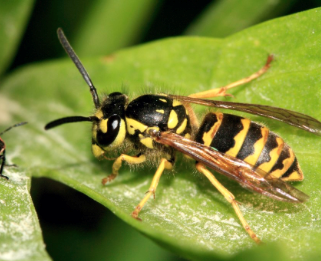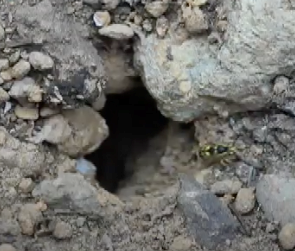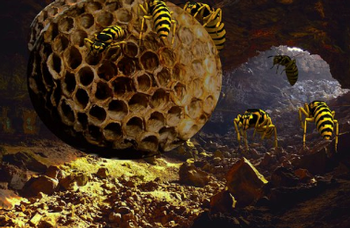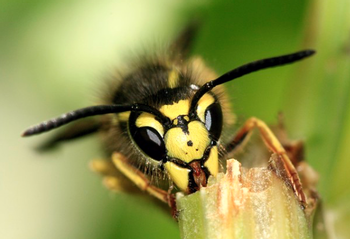Summertime and those pesky yellowjackets
-
Who hasn't had a pleasant dinner on the deck ruined by annoying yellowjackets? Here's how to manage these familiar pests.
Social wasps in California
There are two types of social wasps in California, yellowjackets and paper wasps. As you would expect, social wasps build nests and live in colonies.
Yellowjackets are by far the more troublesome of the two, especially ground- and cavity-nesting ones such as the western yellowjacket, because they vigorously defend their nests when disturbed. This defensive behavior increases as the season progresses and the colony becomes larger while food becomes scarcer.
As you've probably experienced in your own backyard during the late summer and fall, scavenger yellowjackets start to show up at picnics and barbecues, around garbage cans, at dishes of dog or cat food placed outside, and where ripe or overripe fruit is accessible. At certain times and places, the number of scavenger wasps can be quite large and disruptive.
Paper wasps are much less defensive and rarely sting humans. They tend to shy away from human activity except when their nests are located near doors, windows, or other high-traffic areas.
Yellowjacket species Western yellowjacket (V. pensylvanica) Photos courtesy of flickr.com
Western yellowjacket (V. pensylvanica) Photos courtesy of flickr.comYellowjackets are a predatory social wasp. The most commonly encountered species is the western yellowjacket, Vespula pensylvanica, sometimes referred to as the “meat bee.”
These wasps are medium sized and black with jagged bands of bright yellow or white on the abdomen and have a very short, narrow waist where the thorax attaches to the abdomen.
There are seven other species of Vespula wasps found in California. V. vulgaris nests mainly in rotted tree stumps at higher elevations, and V. germanica, the German yellowjacket, nests mainly in houses.
Yellowjacket nests Western yellowjacket underground nest Photo courtesy UC Integrated Pest Management
Western yellowjacket underground nest Photo courtesy UC Integrated Pest ManagementYellowjackets often build nests underground in old rodent burrows, but sometimes they select other protected cavities such as voids in walls and ceilings of houses, as nesting sites. Colonies, which are begun each spring by a single reproductive female, can reach populations of between 1,500 and 15,000 individuals depending on the species.
The wasps build a nest of paper made from fibers scraped from wood mixed with saliva. It is built as multiple tiers of vertical cells, similar to nests of paper wasps, but enclosed by a paper envelope around the outside that usually contains a single entrance hole. If the rodent hole or other cavity is not spacious enough, yellowjackets will increase the size by moistening the soil and digging. Similar behavior inside a house sometimes leads to a wet patch that develops into a hole in a wall or ceiling.
Aerial-nesting yellowjackets, D. arenaria and D. maculata, build paper nests that they attach to the eaves of a building or that hang from the limb of a tree. The entrance normally is a hole at the bottom of the nest. These aerial nesters do not become scavengers at the end of the season and are not as aggressive or troublesome. Yellowjacket nest Photo courtesy of pixabay.com
Yellowjacket nest Photo courtesy of pixabay.comAll species of yellowjackets are extremely defensive when their nests are disturbed. Be very careful if you discover a ground or aerial yellowjacket nest, because some species can bite and sting simultaneously. Wasp stingers have no barbs and can therefore be used repeatedly, especially when the wasp gets inside clothing. As with any stinging incident, it is best to leave the area of the nest site as quickly as possible if wasps become aggressive and start stinging.
Nest building
Typically, previously mated, overwintering yellowjackets and queens begin their nests in spring when the weather becomes warm. The queen emerges in late winter to early spring to feed and start a new nest. From spring to midsummer, nests are in the growth phase, and larvae require large amounts of protein. Workers forage mainly for protein at this time—usually other insects—and for some sugars. By late summer, however, the colonies grow more slowly or cease growth and require large amounts of sugar to maintain the queen and workers. Foraging wasps are particularly interested in sweet things at this time. Normally, yellowjacket and paper wasp colonies live only one season. In very mild climates, yellowjacket colonies survive for several years and become quite large.
Yellowjacket aggressive behavior and sting
Concern about yellowjackets is based on their persistent, aggressive behavior around food sources and their confrontational defense of their nest and colony. Usually stinging behavior is encountered at nesting sites, but sometimes scavenging yellowjackets will sting when you swat them away from a potential food source. When scavenging at picnics or other outdoor meals, wasps will crawl into your soda can and can sting your lips or the inside of your mouth or throat.
Reactions to wasp stings vary from only short-term intense sensations to substantial swelling and tenderness with some itching and life-threatening allergic responses. Of specific concern is a condition that results from multiple-sting encounters induced by the volume of foreign protein injected and the tissue damage caused by destructive enzymes in wasp venom. This can cause tissue damage in the body and require immediate medical attention.
How to manage yellowjackets
Most social wasps provide an extremely beneficial service by eliminating large numbers of other pest insects through predation and should be protected and encouraged to nest in areas of little human or animal activity. Although many animals prey on social wasps—including birds, reptiles, amphibians, skunks, bears, raccoons, spiders, praying mantids, and bald-faced hornets—none provides satisfactory biological control in home situations.
The best way to prevent unpleasant encounters with social wasps is to avoid them. If you know where they are, try not to go near their nesting places. Wasps can become very defensive when their nest is disturbed. Be on the lookout for nests when outdoors. Wasps that are flying directly in and out of a single location are probably flying to and from their nest.
Usually, scavenging wasps will not become a problem if there is no food around to attract them. When nuisance wasps are present outdoors, keep foods, including pet food and drinks, covered or inside the house and keep garbage in tightly sealed garbage cans. Once wasps discover food, they will continue to hunt around that location long after the source has been removed.
The easiest and safest way to get rid of a wasp nest is to call for professional help. If a rapid solution to a severe yellowjacket problem is essential, seek the assistance of a professional pest control operator or consider installing bait stations.
The Marin/Sonoma Mosquito & Vector Control District will eliminate in-ground yellowjacket nests free of charge for residents of Marin and Sonoma counties (if the location of the nest is known and marked). Locating a nest is not easy, as yellowjackets will forage in an area about one-quarter mile in diameter. You may be able to locate the nest by following wasps back to the entrance. For more information go to: Marin and Sonoma Mosquito & Vector Control District yellowjacket control program
Trapping wasps
Trapping is one method that can be employed to try to reduce yellowjacket problems. Trapping is not suggested for other social wasp species.
Lure traps
The easiest traps to use are lure traps, available for purchase at many retail stores that sell pest-controlsupplies. Lure traps can help reduce the number of localized foraging workers, but they do not eliminate large populations. Lure traps contain a chemical that attracts yellowjackets into the traps, but the common lure in traps, heptyl butyrate, attracts primarily the western yellowjacket and not other species. Meat such as chicken can be added as an attractant and is believed to improve catches of the German yellowjacket and V. vulgaris. Replace meat frequently, because yellowjackets are not attracted to rotting meat. Also, periodically check the trap to remove trapped yellowjackets and make sure workers are still attracted to the trap. Lures need to be replaced periodically; follow trap directions regarding replacement.
Lure trap placement and location
It is important to place lure traps in late winter to early spring. To reduce the number of yellowjackets foraging in specific areas such as patios, picnic tables, concession stands, and dumpsters, place lure traps with hepytl butyrate around the periphery. In large areas such as parks, place traps about 200 feet from the area to be protected and about every 150 feet along the circumference. In backyards, it is important to place traps along the edge of the property line as far away from the patio or other protected area as possible. To intercept foraging yellowjackets, it is important to place the traps between the area to be protected and the native landscapes serving as nesting sites.
Water traps
Water traps generally are homemade and consist of a 5-gallon bucket, string, and protein bait such as turkey, ham, fish, or liver. Fill the bucket with soapy water and suspend the protein bait 1 to 2 inches above the water. A wide mesh screen over the bucket will help prevent other animals from reaching and consuming the bait. After the yellowjacket removes the protein, the yellowjacket flies down and becomes trapped in the water and drowns. Like the lure trap, these traps also work best as queen traps in late winter to early spring. In summer and fall, they might assist in reducing localized foraging workers but usually not to acceptable levels. Place water traps away from patio or picnic areas, so wasps are not attracted to your food as well.
Discouraging or eliminating nests
Early in the season, simply knocking down newly started paper wasp nests will cause the founding female to go elsewhere to start again or to join a neighboring nest as a worker. As there is little activity around newly started wasp nests, they are very difficult to find. Wasps are more likely to be noticed after nests and populations grow. Nest removal for controlling subterranean or cavity-dwelling yellowjackets is not practical, because the nests are underground or otherwise inaccessible.
Nest Sprays
Aerosol formulations of insecticides labeled for use on wasp and hornet nests are effective against yellowjackets and paper wasps, but the products must be used with extreme caution. Wasps will attack if they sense a poison being applied to their nests, and even the freeze-type products are not guaranteed to stop all wasps that come flying out. It is prudent to wear protective clothing that covers the entire body, including a veil over your face and gloves. In addition, you need to wear protective eyewear and other clothing to protect yourself from pesticide hazards.
The best time to spray is at night when the wasps are the most likely to be in the nest, but even after dark and using formulations that shoot an insecticide stream up to 20 feet, stinging incidents are likely. Underground nests can be quite a distance from the visible entrance, and the spray might not get back far enough to hit the wasps. Partially intoxicated, agitated wasps are likely to be encountered at some distance from the nest entrance, even the day after an insecticidal treatment.
Again, hiring a pest control professional or calling Marin Sonoma Mosquito & Vector Control will reduce risks to you and your family.
Original article written Eric Mussen and M. K. Rust, Entomology Department, UC Davis and produced by University of California Statewide IPM Program
Edited for the Leaflet by Lisa MacCubbin




